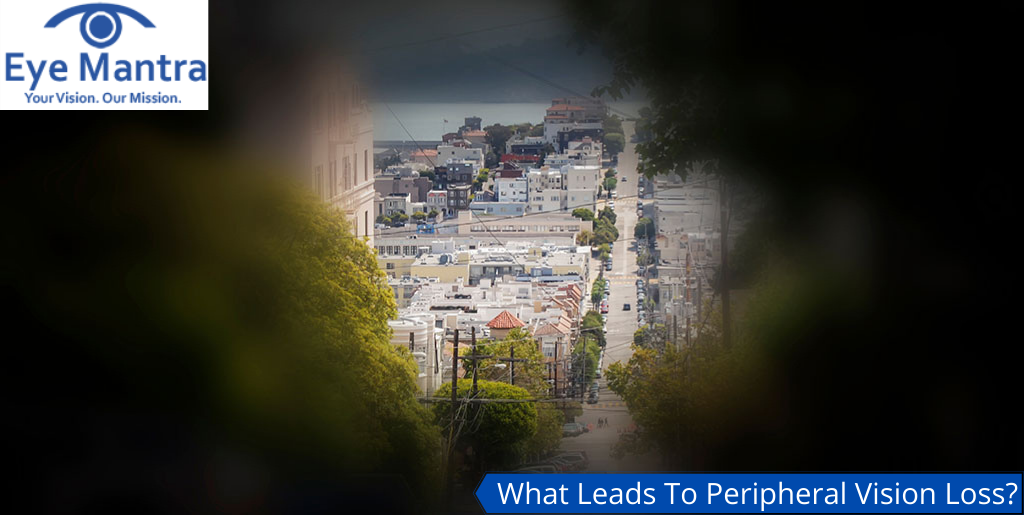Feeling like you’re looking through a keyhole, where everything around the edges has faded into darkness? That’s what peripheral vision loss, or ‘tunnel vision,’ can feel like. It’s a condition that narrows your field of view, making it seem as though you’re viewing the world through a tunnel. If you’ve started bumping into things more often or missing out on objects that aren’t directly in front of you, you might be experiencing the early signs of this vision change.
In this blog, we’re going to unpack everything you need to know about peripheral vision loss. From understanding why it happens to spotting the symptoms and exploring the treatment options, we’ve got you covered.
Contents
What Is Peripheral Vision?
 Peripheral vision helps you see all the objects around you without moving your eyes.
Peripheral vision helps you see all the objects around you without moving your eyes.
But imagine if you could only see what’s right in front of you, like looking through a narrow tube. That’s what it’s like when someone has peripheral vision loss, or what some people call “tunnel vision.” Your side vision starts to disappear, and you’re left with a smaller window to the world.
- Peripheral vision is super important for seeing everything around us without having to turn our heads.
- It helps us walk around without bumping into things, catch a ball thrown from the side, or quickly spot a car coming from the side when crossing the street.
- So, when you start losing this side vision, it can make daily stuff a lot trickier and even a bit dangerous.
This change can affect how well you get around, making it harder to move safely in crowded places or play certain sports. It’s why paying attention to changes in your side vision is really important for keeping you safe and helping you do your day-to-day activities.
Causes of Peripheral Vision Loss
 Several health conditions can sneak up on you and lead to peripheral vision loss, making your world seem narrower. Here’s a look at some common culprits:
Several health conditions can sneak up on you and lead to peripheral vision loss, making your world seem narrower. Here’s a look at some common culprits:
Glaucoma
This is a big one. Glaucoma is an eye disease when the pressure inside your eye gets too high, damaging the optic nerve. It’s sneaky because you don’t feel it and don’t notice the vision loss until it’s quite advanced. Think of it as a slow drain on your side vision.Retinitis Pigmentosa
This condition is less common but pretty impactful. It’s a genetic disorder that affects how the retina responds to light, leading to a gradual loss of both peripheral and night vision. It’s like the lights are slowly turning off around the edges of your vision.Stroke
A stroke can affect various parts of the brain, including those that control vision. Depending on where the stroke happens, it might cause you to lose part of your field of view, making it hard to see to one side.Brain Injuries
Injuries to the brain, whether from accidents or conditions like tumors, can press on the parts that control vision. This pressure can lead to a loss of peripheral vision, depending on which vision pathways are affected.- Diabetic retinopathy
It occurs in diabetic patients because high diabetes can result in a damaged retina. As high blood sugar restricts the functioning of the blood vessels properly.
Peripheral vision loss isn’t always just about the eyes themselves; sometimes, it’s about the brain. So, here are some neurological conditions that can cause this kind of vision loss:
- Brain Tumors
- Multiple Sclerosis (MS), is a disease that affects the central nervous system, leading to the deterioration of the protective covering of nerves
- Injuries to the brain, whether from accidents, falls, or impacts
- Conditions like Alzheimer’s and Parkinson’s disease can also impact vision
Each of these conditions hits the eyes or the brain in a way that narrows your field of view, making it harder to see everything around you. Recognizing the signs early and getting treatment can help slow down the loss and protect your eyesight. So, if you’re noticing changes in your side vision, it’s a good idea to check in with an eye doctor who can help figure out what’s going on.


 Many cases of peripheral vision loss are linked to specific health issues, like glaucoma, retinitis pigmentosa, or neurological disorders. For each of these, there are targeted treatments:
Many cases of peripheral vision loss are linked to specific health issues, like glaucoma, retinitis pigmentosa, or neurological disorders. For each of these, there are targeted treatments:
